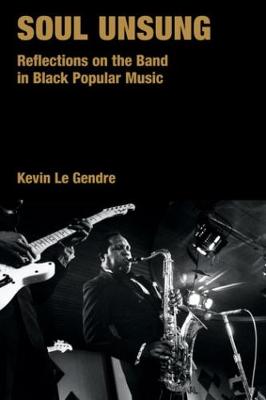Popular Music History
2 total works
The history of Soul music has been defined, first and foremost, by a succession of exceptional vocalists. It is impossible to conceive of the genre without them. This does not mean, however, that those who back singers, those who play instruments - bassists; drummers; guitarists; keyboardists; saxophonists - were reduced to nothing other than walk on parts. If Aretha Franklin and Otis Redding were able to move audiences, then their band members and arrangers, the likes of King Curtis and Booker T. Jones, played a key role in creating tracks that had commensurate emotional depth and technical ingenuity. These lesser known figures have heightened our listening pleasure. In Soul Unsung Kevin Le Gendre celebrates the contribution of players of instruments to soul. He analyses, in forensic detail, the inspiring creativity and imagination that several generations of musicians have brought to black pop, and highlights how they have broadened its sound canvas by adopting unusual stylistic approaches and embracing the latest available technology. Furthermore, the book offers insights into the state of contemporary soul and its relationship with jazz, rock and hip-hop. It is precisely because soul has not evolved in a vacuum that it has a canon that is enviably rich in variety. Soul Unsung shines a light on the plethora of mesmerising sounds that constitute this heritage and explains why they affect the listener as much as a great singer. Placing the focus squarely on the band, Le Gendre sets out to change perceptions of one of the great forms of expression to have marked popular culture in the 20th century, so that those who play are given, alongside those who sing, their rightful place in the pantheon of contemporary music.
Although his activity as a recording artist spanned a period of just three years, from 1967, the year of his arrival in England from America to 1970, the year of his death, Jimi Hendrix created a body of work that has exerted a significant influence on a number of artists in the 20th century and beyond. A headline-grabbing, explosive performer, he is widely recognized as an innovative guitarist who broadened the vocabulary of his instrument through both his technique and daring use of technology. For several generations of critics and audiences, he remains the archetypal rock star who framed his immeasurable talent with lifestyle excesses inherent to his profession.
Hear My Train A Comin' seeks to appraise Hendrix's legacy in different terms. His ability as a soloist is undeniable, but it is not necessarily the defining aspect of his genius. This book focuses on Hendrix the songwriter, a superlative storyteller who was able to combine melody, lyric and arrangement in order to create pieces that take pride of place in the pantheon of post-war popular music. Why do anthems such as Crosstown Traffic, The Wind Cries Mary, Little Wing, Voodoo Child [Slight Return] Purple Haze or Foxy Lady still affect us today? They alchemize word and sound.
These are just a few examples of Hendrix crafting a composition in the most complete sense of the term, making judicious decisions with regard to mood, texture, contrast and overall orchestral richness, looking at his basic resource, the guitar-bass-drums set up as a unit to be enhanced by a range of other instruments and studio production.
This book investigates the artist's immense creativity, and the intriguing relationship he had with the art of song, a platform for a multitude of ideas and improvisation.
Hear My Train A Comin' seeks to appraise Hendrix's legacy in different terms. His ability as a soloist is undeniable, but it is not necessarily the defining aspect of his genius. This book focuses on Hendrix the songwriter, a superlative storyteller who was able to combine melody, lyric and arrangement in order to create pieces that take pride of place in the pantheon of post-war popular music. Why do anthems such as Crosstown Traffic, The Wind Cries Mary, Little Wing, Voodoo Child [Slight Return] Purple Haze or Foxy Lady still affect us today? They alchemize word and sound.
These are just a few examples of Hendrix crafting a composition in the most complete sense of the term, making judicious decisions with regard to mood, texture, contrast and overall orchestral richness, looking at his basic resource, the guitar-bass-drums set up as a unit to be enhanced by a range of other instruments and studio production.
This book investigates the artist's immense creativity, and the intriguing relationship he had with the art of song, a platform for a multitude of ideas and improvisation.

